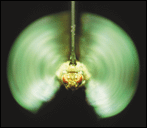

HOW DO FLIES FLY? ON A WING AND A...
Flies are champions of the air, barnstorming through space and engaging one another in aerial dogfights.
But scientists have long been puzzled by a basic question: How do flies guide their flight? No one had ever found a direct connection between the fly's visual system and the muscles that control its single set of wings. Wing steering muscles on the fly did not respond to changing visual images.
Now, Michael Dickinson, an assistant professor of integrative biology, and his Berkeley colleagues have solved the long-standing mystery using a "virtual reality" chamber where they recorded how flies would bank and roll in response to changing images.
With images flickering at a phenomenal rate of 3,000 to 4,000 per second, Dickinson discovered that information from the fly's multiple eyes was feeding to vestigial organs called halteres -- the evolutionary remnants of a second set of wings. The halteres, acting as the fly's gyroscope, would then relay signals to the wing muscles to alter their stroke or angle of attack.
This seemingly illogical system, relaying visual information through a muscle-bound organ, nevertheless is extremely fast. House flies can change course in response to visual images within an amazingly short 30 milliseconds.
"Flies are the most accomplished fliers on the planet in terms of aerodynamics," Dickinson said. "They can do things no other animal can, like land on ceilings or inclined surfaces. And they are especially deft at takeoffs and landings -- their skill far exceeds that of any other insect or bird."
The halteres, beating out of sync with the forewings, are the key to the fly's aerodynamic prowess, he said. Remove a fly's halteres, and it becomes unstable and quickly crashes to the ground.
![]()

[Table of Contents] [Berkeley Magazine Home] [UC Berkeley Home Page]
Copyright 1998, Regents of the University of California. All rights reserved.
Comments? E-mail ucbwww@pa.urel.berkeley.edu.